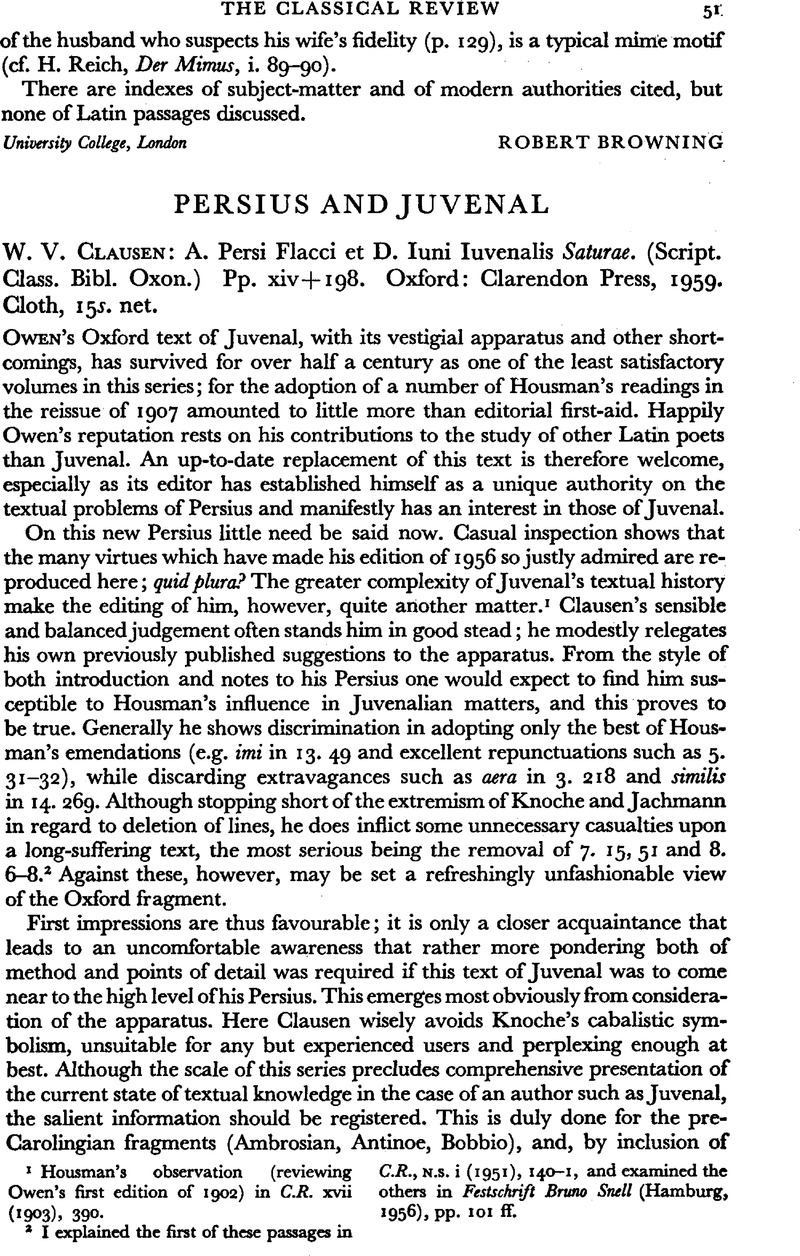Published online by Cambridge University Press: 27 February 2009

page 51 note 1 Housman's, observation (reviewing Owen's first edition of 1902) in C.R. xvii (1903), 390Google Scholar.
page 51 note 2 I explained the first of these passages in C.R., N.s. i (1951), 140–1, and examined the others in Festschrift Bruno Snell (Hamburg, 1956) PP. 101 ff.
page 52 note 1 Thus newly found manuscripts, such as the sixteen whose readings have recently been published by A. Gruzewski in Poland, fit in to the classification as well as can be expected in so ‘mixed’ a tradition. See C.R. N.S. viii (1958), 287–288Google Scholar.
page 52 note 2 The others are K (Laur. 34. 42) and Z (Lond. Mus. Brit. add. 15600). K resists precise classification, but has interest enough to warrant its inclusion by siglum; it is curious that Housman only mentioned its readings intermittently, as these were known to Jahn (1851; denoted there as a) and to Hosius (1888, as R). Z is the fourth of the major representatives of the Λ group; it does not add much to what one would infer from F, L, and O.
page 53 note 1 Other places where this manuscript may offer a reading of value are 7. 215, 218, and 235: 10.87: and perhaps sagina in 4. 67. Its transposition of 6. 307 and 308 (shared with K; PQR all omit 307) might suggest that these two lines are ancient alternatives, per- naturalisparsphilosophiaeinduoscindihaps author-variants; for whichever of them precedes the other the passage limps, yet subwith either omitted, a vigorous sense results.
page 53 note 2 Curiously Housman, who had rebuked Owen for making reference to this trivial transposition in his text of 1902 (C.R. xvii [1903] 391), allowed the same entry to stand in his own apparatus two years later.
page 53 note 3 As early as c. A.D. 500 it seems to have been necessary to warn readers that scindens here does not mean ‘tear up’, as it certainly does in Martial ix. 73. 9. Quintilian, i proem. 13 (‘scidit se studium…ut artes esse plures videretur’) and Seneca, Epp. 89. 16 (‘naturalis pars philosophiae in duo scindihaps tur… utraque dividuntur in suos ut ita dicam gradus’) demand the sense of ‘subwith divide’, which is in point here. The musicians Pollio and Chrysogonus are getting the lion's share of the rewards for teaching only one subdivision of what to Theodoras of Gadara was the unified art of rhetoric. The participle stands; scindes in B (Leid. Voss. F 64) need be no more than a clerical slip.
page 55 note 1 Owen jettisoned the truth in his second inedition of 1907 in favour of a specious emen- dation.
page 55 note 2 A. J. Phil. xlv (1924), 277–278Google Scholar.
page 55 note 3 I still think that the reconstruction I improposed for this line (.C.R., N.s. i[1951], 139) points to the truth, but I admit that it is difficult to take sanctum and ab together in the required sense. Recognizing now (as I introdid not then) the possibility of Juvenal's having written set on occasion, I believe the text ran: praeterea sanctum nihil est, 〈set〉 ab inedition guine tuta
non matrona laris….
The omission of set in PR would be a form lipography from the letters of est improposed mediately preceding, and with its loss the subsequent textual degeneration would have occurred much as previously suggested. For tutus with ab, cf. 11. 146, and for sed introdid during a complex of negatives, cf. 8. 217 f.
page 56 note 1 I am grateful to the Rev. J. Ashton of Campion Hall, Oxford, for kindly allowing me to place his suggestion on record here.
page 56 note 2 Cf. Aen. xii. 510, etc. Perhaps too Eel. ix. 13 is relevant: doves are helpless aquila veniente.
page 56 note 3 Cf. Livy xxvi. 51. 8 or xxxix. 48. 5.
page 57 note 1 Presumably Knoche's remark in his ap- paratus on 8.233 applies only to the plural form parastis; if it does not, it is in- correct.
page 57 note 2 See Bailey, D. R. Shackleton in J.R.S. xliii (1953), 224Google Scholar.
page 57 note 3 Putat is corrupted to putant in the vulgate in 14. 121.